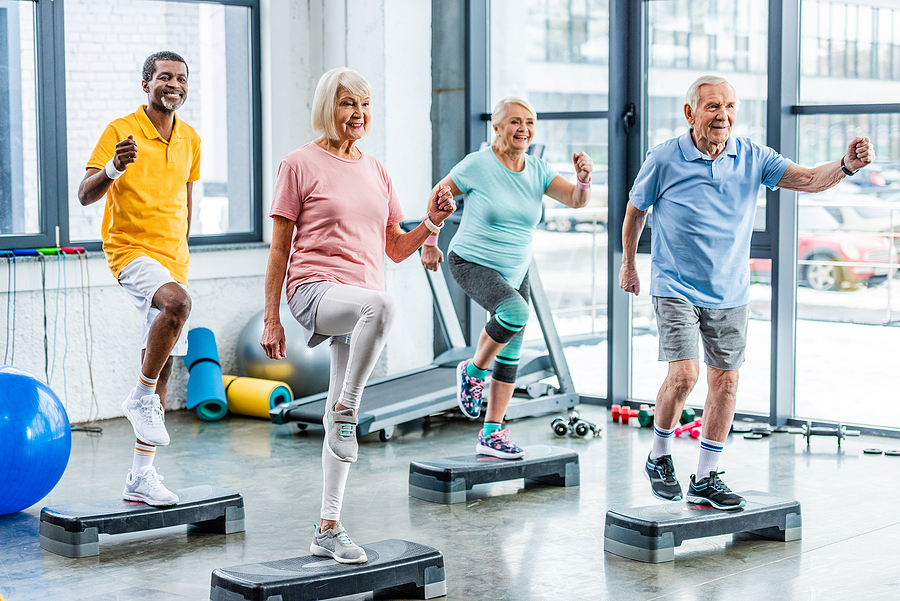In the upper half of the country, summertime presents many opportunities to enjoy the outdoors. While such physical activity has an array of health benefits for seniors, many people become increasingly inactive as they age, often as the result of chronic conditions or mobility limitations. In fact, according to the CDC, by the age of 75, about one in three men and one in two women engage in no physical activity, though it is recommended that people 65 and older get at least 150 minutes a week of moderate-intensity activity.
So, what can continuing care retirement communities (CCRCs, or life plan communities) and other senior living communities do to help encourage and facilitate physical activity among their residents? A new report sheds light on this important topic.
The many perks of seniors staying active
To some extent, the decrease in physical activity that commonly occurs with age may be a chicken and egg scenario. The loss of strength and stamina that is often attributed to aging is caused in part by reduced physical activity … which in turn results in additional loss of strength and stamina.
Yet the health benefits of remaining active are undeniable. The CDC notes the following perks of physical activity:
- Helps maintain the ability to live independently and reduces the risk of falling and fracturing bones.
- Lowers the risk of dying from coronary heart disease and of developing high blood pressure, colon cancer, and diabetes.
- Can help lower blood pressure in some people with hypertension.
- Helps people with chronic, disabling conditions improve their stamina and muscle strength.
- Reduces symptoms of anxiety and depression and fosters improvements in mood and feelings of well-being.
- Helps maintain healthy bones, muscles, and joints.
- Helps control joint swelling and pain associated with osteoarthritis.
>> Related: Adult Swim: Study Finds Senior Swimmers Less Likely to Experience Falls
What’s holding seniors back from physical activity?
Even knowing the many wellness benefits of moving our bodies, only 43 percent of people 65 to 74 years old meet the CDC’s recommendations for physical activity, and even fewer in older age groups, according to a recent report released by The Mather Institute, which conducts research on senior living and community-residing older adults.
Among the barriers that keep older people from being more physically active, according to Mather’s research, are:
Low awareness
Many seniors are not cognizant of how much physical activity they should be engaging in each day and thus don’t meet the CDC’s recommended amount. Additionally, community-dwelling seniors may not be aware of programs intended to help them stay fit, such as low- or no-cost gym or fitness program memberships.
The Mather report notes, “While cost and proximity are considerations for community-dwelling older adults, programs within a senior living community are generally easy for residents to access, so the first step in getting residents engaged is to utilize information-sharing systems (e.g., community calendars) to provide an accurate program description.”
Lack of knowledge
A commonly cited obstacle to physical activity for many seniors is lack of understanding about what types of exercises they should be doing, particularly those who have health issues or some level of physical hindrance (such as arthritis). And oftentimes, doctors are not providing helpful guidance on safe and effective exercise options for their older patients — particularly low-income seniors.
Improving education and instruction about appropriate types of exercise has been shown to effectively boost activity levels in older adults, however. For senior living residents, the Mather report observes, “Offering training or health information sessions to new residents and providing extra instruction to residents who are just beginning an activity program may be one solution. Providing timely information about alternative activity options may be another solution for residents who are undergoing age-related changes.”
The report also notes the availability and convenience of virtual exercise resources, which require only an internet-connected computer or smartphone and can be done in the comfort of a person’s home.
Personal preferences
While some seniors love the feeling of exercising, others say a lack of motivation or a disdain for structured exercise holds them back from being physically active.
The Mather report suggests a solution. “While finding activities that residents enjoy is important, there is also potential to help them learn to like exercise by focusing on positive experiences and sensations in the moment, and reflecting on these feelings afterward.” The report also notes the potential benefits of adding a “virtual component to a physical activity plan” through smartphone apps and gamification.
Physical ability challenges
Concerns about sustaining an injury or falling, as well as issues caused by chronic medical conditions and mobility challenges, are common hindrances to seniors’ physical activity, as well. But the Mather report observes that these issues can and actually should be reframed as reasons to actually get more physical activity. “Reframing physical activity as a facilitator of function rather than a barrier to overcome may encourage senior living residents to exercise more,” the report says.
Psychosocial barriers
The Mather report also lists a number of common psychosocial obstacles to seniors’ physical activity, including:
- Low confidence in one’s ability for exercise
- Negative perceptions of aging
- Perceived norms
- Lack of socialization
- Loneliness
- Social anxiety
- Delayed gratification
>> Related: Fore!: Why Sports Like Golf Might Prolong Seniors’ Lives
CCRCs can get residents moving
The good news is that living in a senior living community — and perhaps particularly in a CCRC — can help seniors overcome most, if not all, of these impediments to physical activity.
Most CCRCs offer an array of health and wellness programs for their residents, including group exercise classes, gyms, and indoor pools. There are often sports offerings as well such as golf, tennis, pickleball, and more, which can provide residents not only some good exercise but also a healthy dose of fun and competition.
Many CCRC campuses are laid out to be highly walkable with sidewalks, walking paths, or trails. Some communities even have personal trainers on staff who can help residents find a safe and effective exercise routine that the senior actually enjoys and looks forward to.
In addition, the sense of community within a CCRC may create some healthy “peer pressure” as less active residents see or hear about other more active residents participating in exercise regimens. Indeed, support from family and friends is consistently correlated with getting more regular physical activity, and as the Mather report observes, “Seeing one’s peers [or life partner] staying active can be very influential.”
>> Related: Why Walkability is Important When Choosing a Senior Living Location
Ways CCRCs can further encourage residents
While many CCRCs are proficient at communicating with their residents and encouraging them to stay physically active, there are almost always ways to get even better. The Mather report makes a number of suggestions for improvement among senior living communities including:
- Expanding resident communications and education about group or individual exercise opportunities
- Getting creative with exercise programming and bringing in a social element to it so that exercise becomes more enjoyable
- Promoting the many benefits of exercise to prevent or manage chronic health problems or mobility issues
- Boosting residents’ confidence in their abilities and helping them embrace a more positive view of aging
You can download the full Mather Institute report entitled, “Stumbling Blocks: Identifying and Overcoming Older Adults’ Barriers to Physical Activity.”






